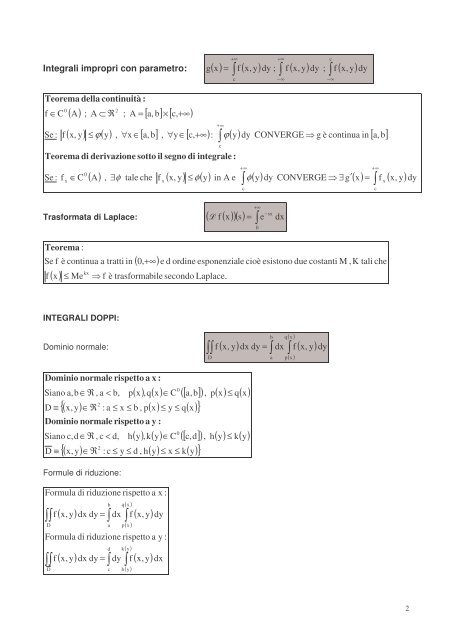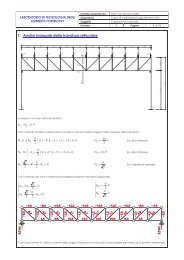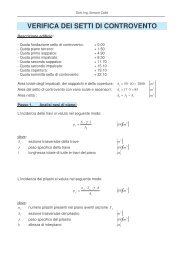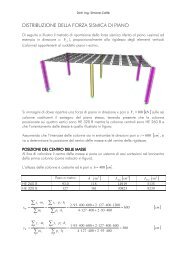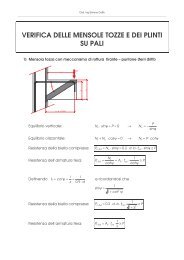You also want an ePaper? Increase the reach of your titles
YUMPU automatically turns print PDFs into web optimized ePapers that Google loves.
Integrali impropri con parametro: g(<br />
x)<br />
= f ( x,<br />
y)<br />
dy ; f ( x,<br />
y)<br />
dy ; f ( x,<br />
y)<br />
Teorema della continuità :<br />
f ∈C<br />
Se :<br />
Se :<br />
f<br />
f<br />
0<br />
2<br />
( A)<br />
; A ⊂ ℜ ; A = [ a, b]<br />
× [ c,<br />
+∞)<br />
+ ∞<br />
+∞<br />
c<br />
+∞<br />
−∞ −∞<br />
( x, y)<br />
≤ ϕ(<br />
y)<br />
, ∀x<br />
∈[<br />
a, b]<br />
, ∀y∈<br />
[ c,<br />
+∞)<br />
: ϕ(<br />
y)<br />
dy CONVERGE g è continua in [ a, b]<br />
Teorema di derivazione<br />
sotto il segno di<br />
x<br />
∈C<br />
0<br />
( A)<br />
, ∃φ<br />
tale che f ( x, y)<br />
≤ φ(<br />
y)<br />
in A e φ(<br />
y)<br />
dy CONVERGE ∃g′<br />
( x)<br />
= f ( x,<br />
y)<br />
x<br />
c<br />
integrale :<br />
Trasformata di Laplace: ( f ( x)<br />
)( s)<br />
Teorema :<br />
f<br />
( 0, +∞)<br />
e<br />
kx ( x)<br />
≤ Me f è trasformabile<br />
secondo Laplace.<br />
Se f è continua a tratti in<br />
INTEGRALI DOPPI:<br />
c<br />
dy<br />
+ ∞<br />
+ ∞<br />
c c<br />
=<br />
+∞<br />
0<br />
e<br />
−sx<br />
dx<br />
d ordine esponenziale<br />
cioè esistono due costanti M , K tali che<br />
Dominio normale:<br />
b q(<br />
x )<br />
f ( x,<br />
y)<br />
dx dy = dx f ( x,<br />
y)<br />
dy<br />
D<br />
a p(<br />
x )<br />
Dominio normale rispetto a x :<br />
Siano a, b<br />
D ≡<br />
D ≡<br />
0<br />
∈ℜ<br />
, a < b, p(<br />
x)<br />
, q(<br />
x)<br />
∈C<br />
( [ a,<br />
b]<br />
) , p(<br />
x)<br />
≤ q(<br />
x)<br />
2 ( x,<br />
y)<br />
∈ℜ<br />
: a ≤ x ≤ b , p(<br />
x)<br />
≤ y ≤ q(<br />
x)<br />
{ }<br />
Dominio normale rispetto a y :<br />
Siano c, d<br />
0<br />
∈ℜ<br />
, c < d, h(<br />
y)<br />
, k(<br />
y)<br />
∈C<br />
( [ c,<br />
d]<br />
) , h(<br />
y)<br />
≤ k(<br />
y)<br />
2 ( x,<br />
y)<br />
∈ℜ<br />
: c ≤ y ≤ d , h(<br />
y)<br />
≤ x ≤ k(<br />
y)<br />
{ }<br />
Formule di riduzione:<br />
Formula<br />
di riduzione rispetto a x :<br />
D<br />
D<br />
f<br />
( x )<br />
( x,<br />
y)<br />
dx dy = dx f ( x,<br />
y)<br />
( x )<br />
Formula di riduzione rispetto a y :<br />
f<br />
( y)<br />
( x,<br />
y)<br />
dx dy = dy f ( x,<br />
y)<br />
b<br />
a<br />
d<br />
c<br />
q<br />
p<br />
k<br />
h<br />
( y)<br />
dy<br />
dx<br />
x<br />
2<br />
dy


